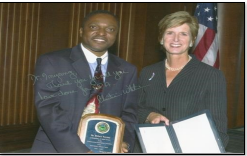North and Central America is a region of great cultural and socio-economic diversity. Many factors such as population migration, agriculture, natural disasters, land quality degradation, energy system sustainability and transboundary environmental pollution impact upon human and infrastructure development, and the geopolitics of this region. With the United States as his base, Prof. Hilary Inyang has led many technical programs in this region. For about ten years, starting in 1992, he joined Prof. Raj Singhal of Canada to organize a series of conference sessions in Calgary, Canada to address environmental issues relevant to mining and energy industries. These events typically attracted experts and policymakers from throughout the Americas. As a panelist and co-convener of the geoenvironmental engineering expert panel at the US-Canada Workshop on Recent Accomplishments and Trends in Geomechanics in the 21st Century held in Norman, Oklahoma, USA in October 21-23, 1992, Prof. Inyang helped formulate the scope of the field which was subsequently used by the US National Science Foundation for grant planning. Since then, he has served as an external examiner of doctoral candidates at McGill University, Montreal, Canada (1996), University of Alberta, Edmonton, Canada (2006) and University of Calgary, Canada (2006). Prof. Inyang was a panelist on Renewable Energy and Natural Resources during the 2004 Summit on Partnering for
Sustainability, held in Toronto, Canada. He has been an invited evaluator for the Natural Sciences and Engineering Research Council of Canada (NSERC) (2005, 2006). In September 2004, he was a member of the group of experts selected by the US National Science Foundation to present advances in the fields of geoenvironmental engineering at the workshop organized in Mayaguez, Puerto Rico on geoenvironmental issues facing the Americas. Within professional circles in the United States, he has been an active researcher, policy proponent, educator and public intellectual on energy, environment and natural disaster aspects of sustainable development. Specific outlines of his contributions are provided in section B.1. Owing to the threats to life, the environment and infrastructure posed by natural disasters in Central America and the Gulf Coast of the United States, Prof. Inyang used his role as the President of the Global Alliance for
Disaster Reduction (GADR) to lead efforts on mitigation programs and events. He coedited a compendium of best practices entitled “Blue-Prints for Change” for disaster prevention, in collaboration with Dr. Walter Hays of GADR and Dr. Badaoui Rouhban of UNESCO. The blueprints have been used widely in disaster management efforts worldwide.

No responses yet